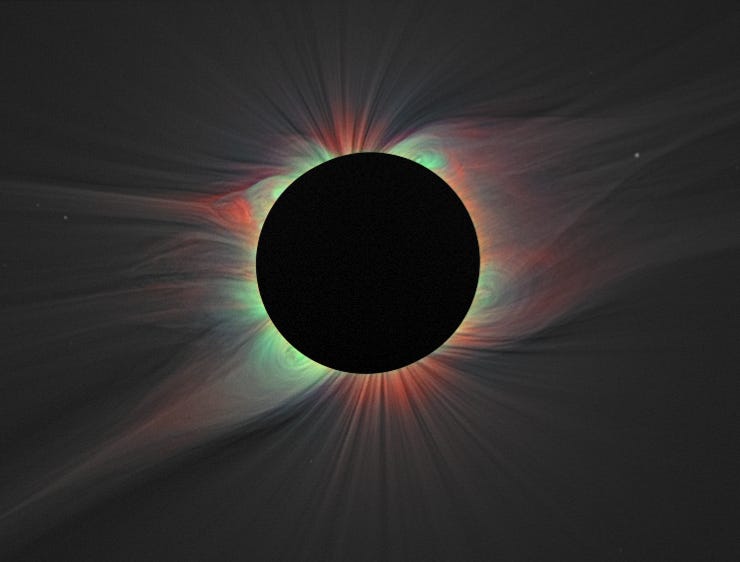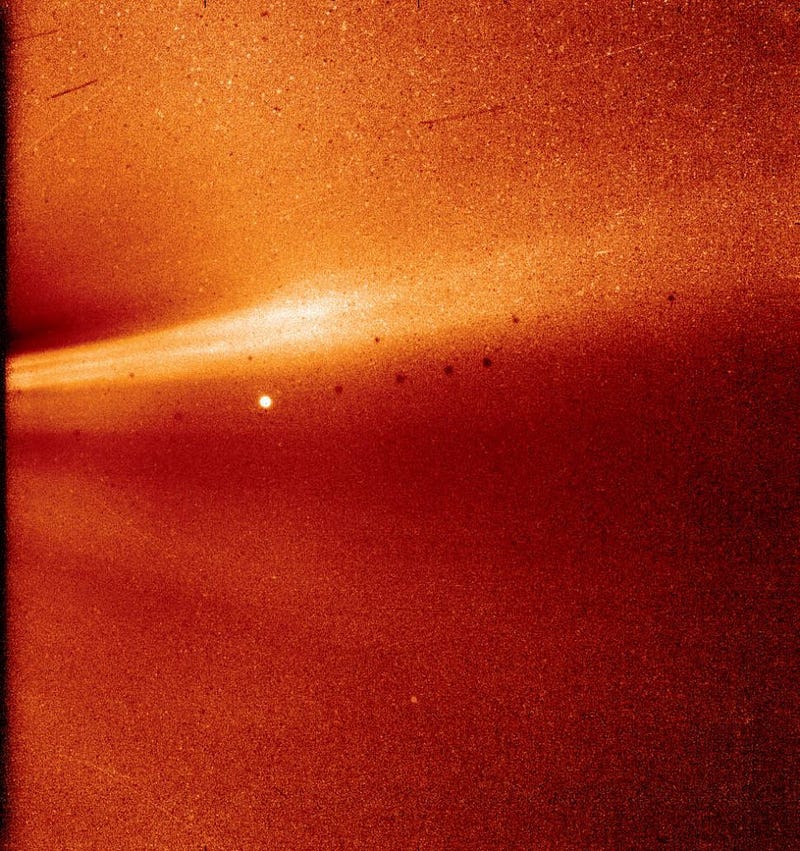Exploring the Sun's Secrets: Alfvén Waves and Solar Heating
Written on
Chapter 1: The Enigma of Solar Heating
Recent research has unveiled intriguing insights into the magnetic waves within the Sun's plasma, suggesting they may be fundamental to understanding solar phenomena. As we delve deeper into these mysteries, we are fortunate to have advanced spacecraft exploring the Sun's atmosphere.

The above image depicts the solar corona, showcasing a color overlay of emissions from highly ionized iron lines captured during a 2008 eclipse. The colors represent different iron lines: red for Fe XI at 789.2 nm, blue for Fe XIII at 1074.7 nm, and green for Fe XIV at 530.3 nm. Credit: Habbal, et al.
In the 19th century, German scientists pioneered the use of spectroscopy to analyze light, akin to the way a prism works. This technique revealed various atomic elements based on how different atoms absorb or emit light, appearing as distinct lines at varying frequencies along the electromagnetic spectrum. Astronomers quickly began to use spectroscopy to uncover the chemical composition of celestial bodies, including our Sun.
This method led to the groundbreaking discovery of helium, the second most abundant element in the universe, during a total solar eclipse in 1868. It wasn't until 1882 that helium was identified on Earth when Italian physicist Luigi Palmieri found it in Mount Vesuvius' lava.

Credit: Fraunhofer USA
Helium wasn't the only peculiar signature detected in the Sun's atmosphere. Around the same time, scientists identified a spectral line that didn't match any known earthly element, leading to the term "coronium." This was believed to be an undiscovered element until the 1930s, when it was revealed to be a highly charged ion of iron—an atom stripped of 13 of its 26 electrons, a state only achievable at extremely high temperatures.
This finding highlighted an unusual characteristic of the Sun: its upper atmosphere is significantly hotter than its surface, which contradicts our understanding of physics. Astrophysicist Ian O'Neill notes, "It’s like measuring the temperature of the air surrounding a light bulb and finding it much hotter than the bulb itself."
Despite ongoing research for nearly a century, the reason for this discrepancy remained elusive. However, recent studies have begun to connect magnetohydrodynamics—specifically, the behaviors and movements of plasma—to the heating of the Sun's atmosphere.
Section 1.1: Unraveling the Temperature Mystery
The Sun's photosphere, its visible surface, ranges from 4500 to 6000 degrees Kelvin. Yet, the corona’s temperature soars into the millions, enabling the ionization of heavier elements like iron, nickel, and calcium. Interestingly, the heavier ions can reach temperatures ten times greater than hydrogen, creating a phenomenon dubbed the "zone of preferential heating."
Since the early 20th century, various hypotheses have emerged, including explosive events called nanoflares and magnetic waves traversing the electrified plasma.
Subsection 1.1.1: The Role of Alfvén Waves
In a recent paper published in The Astrophysical Journal Letters, researchers from the University of Michigan, Justin Kasper and Kristopher Klein, have identified a crucial link between the heated ions and magnetic oscillations known as Alfvén waves. These waves, named after Nobel laureate Hannes Alfvén, play a vital role in plasma physics.
Their study establishes a connection between the regions where ions heat up and the rapid, low-frequency magnetic waves that travel through the Sun’s atmosphere. Having previously measured how far these ions were heated, the team was able to compare the zones of preferential heating with the Alfvén wave propagation limits, known as the Alfvén point.
Their findings revealed that the heating zone extends approximately 10 to 50 times the Sun's radius. Remarkably, they noted that the outer boundaries of the heating zone and the Alfvén point shifted in a synchronized manner despite being derived from independent calculations. Kasper expressed his astonishment, stating, "You overplot them, and they’re doing the exact same thing over time."
This video, titled "Unveiling the Mysteries of Solar Magnetic Activity: Parker Solar Probe and Solar Orbiter," explores the complex interactions of magnetic waves and solar activity, providing further insights into these phenomena.
The researchers propose that these magnetic waves could be the driving force behind the heating of ions, as well as the lighter particles at the Alfvén point's edge. Particles at this boundary contribute to the solar wind, which escapes into the solar system as the magnetic forces weaken against thermal energy.
"The aim is to quantify this region of preferential heating of heavy ions, potentially confirming that 'Alfvén wave heating' is the primary process behind the corona's heating," explains O'Neill. If validated, it might clarify the mechanisms that heat the broader solar corona, potentially solving the coronal heating conundrum.
Chapter 2: The Parker Solar Probe's Mission
The Parker Solar Probe (PSP), launched in August 2018, is set to revolutionize our understanding of the Sun by making unprecedented close-up observations of its atmosphere. By November 2018, it broke the record for the closest approach to the Sun, coming within 42 million kilometers. In April 2020, it passed even closer, at a staggering speed of 342,000 kilometers per hour.
In this video titled "What is Space Weather? [Solar Storms]," viewers can learn about the implications of solar activity on Earth, including potential disruptions caused by solar wind and coronal mass ejections (CMEs).
The PSP's ongoing mission aims to investigate the inner solar atmosphere's dynamics. In late 2020, it is expected to cross into the zone of preferential heating, using its sensors to measure the Sun's magnetic field at an astounding rate of two million times per second. "This mission will be the first to make direct measurements of the plasma environment within the Sun’s super-heated atmosphere, providing invaluable insights into coronal heating mechanisms that have only been indirectly measured for decades," states O'Neill.

This image from the Parker Solar Probe shows a coronal streamer, a bright structure emerging from active solar regions, with Mercury visible in the center. (Image: © NASA/Naval Research Laboratory/Parker Solar Probe)
Understanding the Sun's atmosphere is critical, as it generates solar wind, which bathes the planets in ionized particles. Occasionally, massive bursts of plasma, known as CMEs, are expelled from the Sun. During periods of heightened solar activity, these can occur multiple times daily, leading to potential disruptions on Earth.
In 1989, a solar storm caused a significant blackout in Quebec, highlighting the importance of monitoring solar weather. The charged particles from solar wind can create stunning auroras at the poles but can also induce harmful interactions that disrupt electrical systems.
Gaining insights into these solar phenomena is vital for developing better predictive models to mitigate the risks associated with severe solar events. The Parker Solar Probe's exploration may ultimately establish the link between solar weather and Alfvén waves, enhancing our ability to forecast space weather and protect our technological infrastructure from potential damage.